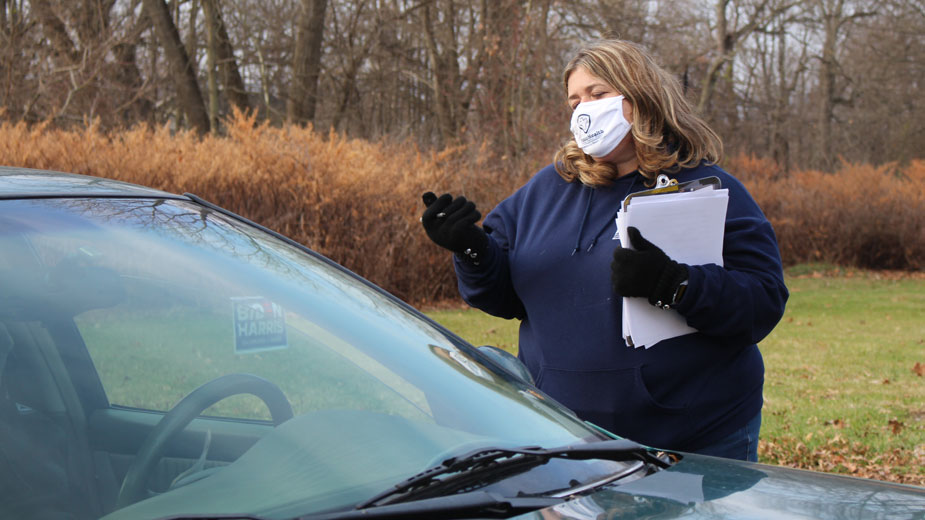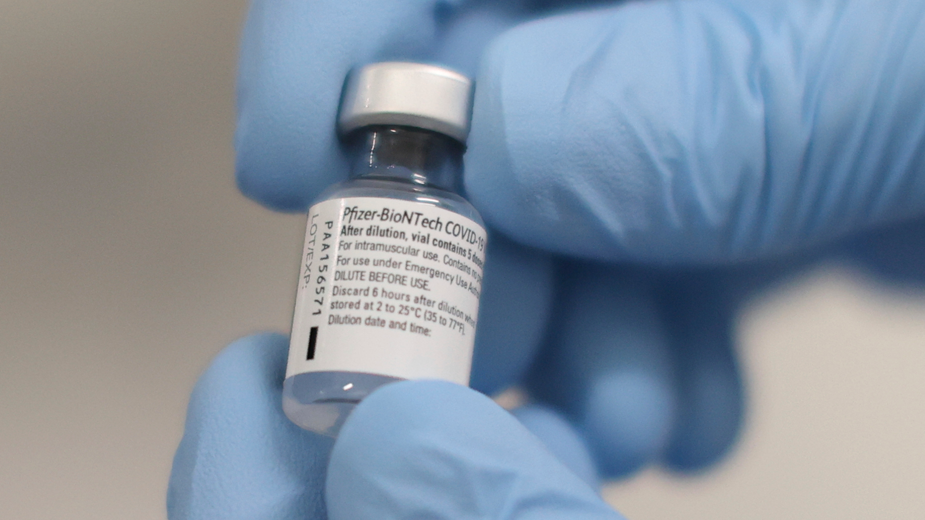With Vaccine on Horizon, Health Departments Still Have Questions
YOUNGSTOWN, Ohio – As cars lined up for blocks to get tested for COVID-19 at Dorothy Day House Thursday, Youngstown City Health District commissioner Erin Bishop said there’s little doubt that the city is in the midst of one of the worst phases of the pandemic so far.
“Just in surveys and talking to people as they prepare to get tested, a lot of them have been in contact with someone who tested positive recently,” she said. “This is when we’d expect to start seeing that bump. We’re two weeks out from Thanksgiving and this is when symptoms would be showing up. … It’s hard. This is the holidays and people want to be with their families. We’re seeing, from our contact tracing and epidemiology, a lot of families that need calls to let them know they’ve been in contact.”
Thursday afternoon, as the drive-thru testing clinic at the Belmont Avenue site was wrapping up, the Ohio Department of Health reported 274 new COVID-19 cases in Mahoning County, bringing its cumulative total since the start of the pandemic to 11,096. There have been 310 coronavirus-related deaths in the county.
The department is starting to be strained, Bishop said, including its 10 full-time contact tracers. Helping somewhat are volunteers from the Youngstown City Health District’s environmental health division to work weekends, as well as medical staff outside the department.
“Right now, we’re able to manage but it’s tight. … If we get 60 a day and they’re in contact with 10 people, that’s 600 calls to make,” she says, although tracers also have to answer returned calls if the initial call from the health department is missed and answer any questions the patient may have.

As the numbers are continuing to rise – a trend that’s expected to continue with Christmas and New Year’s fast approaching, two holidays that tend to draw gatherings of family and friends – there is some light on the horizon as Pfizer’s vaccine was given approval by an advisory panel at the Food and Drug Administration Thursday evening. The next step for the vaccine, expected within days, is the emergency authorization by the FDA for use in those 16 and older.
If approved, plans created by federal, state and local officials will be set in motion to begin the distribution of the vaccine.
First up will be 10 hospitals in the state that will receive a combined 9,750 vaccines for their frontline workers, as well as 88,725 vaccines for CVS and Walgreens to administer in the state’s long-term care centers. If the planned timeline holds, the doses from Pfizer will start arriving at their destinations Dec. 15.
The 10 hospitals, Gov. Mike DeWine said in his press conference Thursday, were chosen because of their ability to store the Pfizer vaccine, which needs to be kept at -94 degrees Fahrenheit. The hospitals are Mercy Health-St. Vincent Medical Center, Cleveland Clinic Main Campus, MetroHealth Main Campus, Mercy Health-Springfield Regional Medical Center, Wexner Medical Center, UC Health, OhioHealth-O’Bleness Hospital, Genesis Hospital and Aultman Hospital, the only site in Region 5 – which includes Mahoning, Trumbull and Columbiana counties – to receive the vaccine at first.
The following week, 201,000 vaccines from Moderna will be shipped to the state’s 98 other hospitals and 108 health departments to vaccinate frontline workers.
“If we get the shipment on the 22nd like we want, that would go to both local hospitals and the health department. We don’t know how much we’re going to get,” said Laura Fauss, public information officer for the Columbiana County Health Department. “The state says they’re going to allocate by total population and vulnerable population, but they didn’t tell us what exactly that means or how many doses we’ll get.”
In addition, Pfizer is scheduled to deliver a shipment of 123,000 doses for Walgreens and CVS for use in long-term care centers. “A few days later,” the state will receive another 148,000 vaccines from Pfizer and 89,000 from Moderna, according to the Ohio Department of Health’s coronavirus vaccination program webpage.
“We have to wait for approval and for the federal government to put that green flag out there. Once that’s down, we’re moving forward,” DeWine said. “[Pfizer has] assured us that shipments will be made almost immediately to us. They’re ready to go.”
But exactly how many doses each health department and hospital will receive isn’t known, according to local public health officials. Bishop said the Youngstown City Health District has told the state health department how many doses they need “but we’re kind of at their mercy” for how many are delivered.
At Mahoning County Public Health, commissioner Ryan Tekac said the agency started reaching out to first responders to know how many vaccines those workers want. All vaccinations for the coronavirus are optional.
“We started that this week. Knowing that we don’t have full information from the state, the plan could potentially change,” he said, noting that health departments across Ohio will have a conference call with the ODH Friday.
At the Columbiana County public health agency, Fauss said the goal is to start vaccinating EMS workers in their jurisdiction Dec. 28, but said those plans are not set in stone. The information the agency is working with could be changed by Friday’s call, requiring plans to be changed.

“Ideally, we’d like to start vaccinating EMS the week of the 28th. If hospitals need more – they’re supposed to vaccinate their own employees – we might give ours to them,” she said. “It all depends because we don’t know how much they’re getting either. From there, we go through the tiers, continuing with EMS workers and then other health-care workers that aren’t in hospitals.”
Once vaccines arrive and begin being distributed, whether to frontline workers and long-term care residents initially or the general public in the spring, one of the key tasks will be ensuring everyone gets the pair of doses required for it to be fully effective. Both the Pfizer and Moderna vaccine require an initial dose and a booster dose given two weeks later.
The state will have a database that groups administering the vaccine can enter patient information into, the public health officials say. But beyond that, there isn’t much information available yet.
“The state has some information in their draft policy, but since that’s not set in stone, we don’t have a definite policy yet. In-house, we’re thinking about doing a card we give people when they first get vaccinated to set up their next dose,” Fauss said. “The federal government is holding back those doses, so we don’t have to worry about saving enough to do the booster doses. We should get another shipment about a week before people first need boosters.”
As for where the public can get vaccinations once the state works through its initial stages, Tekac suggested Mahoning County may see something similar to the H1N1 pandemic, when a drive-thru clinic was set up at the Canfield Fairgrounds.
“With this virus, the understanding has always been that we can’t bring lots of people into big buildings,” he said. “The logistics may look a little different [from H1N1], which could mean those kinds of drive-thru clinics or are more planned, where people have scheduled times they get their vaccine so there’s time to disinfect and ensure people aren’t gathering.”
In Columbiana County, Fauss said the health department’s goal is to have the vaccine available in as many places as possible and making it easily accessible.
At the Dorothy Day House drive-thru testing clinic, Bishop said the event could serve as a test run for mass distributions of the vaccine. Thursday morning, Youngstown City Health District workers went from car to car as they waited in line, collecting patients’ information before they drove through a pair of tents and got swabbed.
Once enough vaccines are available, Bishop said, the plan is to take testing sites into neighborhoods around the city, providing for better access.
“Even this morning, we had a few people come out onto their front porches and ask what’s going on,” she said. “Mostly it’s been cars coming through, but we’ve had people walk in to get tested as well.”
Pictured at top: Health-care workers administer and collect COVID-19 tests at a drive-thru clinic hosted by Youngstown City Health District and Dorothy Day House on Thursday. Such events could be a test run for how vaccinations are distributed, said city health commissioner Erin Bishop.
Copyright 2024 The Business Journal, Youngstown, Ohio.



